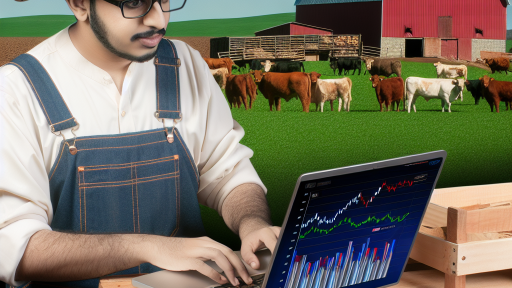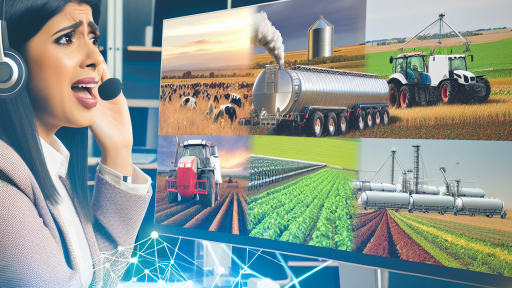Integration of Technology and Precision Agriculture
Overview of Precision Agriculture
Precision agriculture uses technology to optimize farm management.
This approach enhances crop production while minimizing waste.
Farmers can utilize data-driven insights to make informed decisions.
Technology in Sustainable Farming
Innovative technologies like drones and sensors are gaining popularity.
Drones provide aerial imagery for crop monitoring and analysis.
Sensors collect real-time data on soil moisture and nutrient levels.
The Role of Data Analytics
Data analytics play a crucial role in precision agriculture.
Farmers can analyze data to identify patterns and trends.
This analysis helps in predicting crop yields and improving practices.
Benefits of Precision Farming
- Increased efficiency in resource usage.
- Reduced environmental impact through targeted application.
- Improved crop health and pest management.
Emerging Technologies in Agriculture
Artificial Intelligence (AI) enhances decision-making processes.
AI tools can predict weather patterns to aid planning.
Moreover, machine learning algorithms optimize irrigation systems.
Future Prospects of Integrated Technologies
As technology evolves, precision agriculture will become more accessible.
Farmers will likely adopt advanced tools to boost sustainability.
Ultimately, this integration can lead to a more resilient food system.
Transform Your Agribusiness
Unlock your farm's potential with expert advice tailored to your needs. Get actionable steps that drive real results.
Get StartedThe Role of Organic Farming in Sustainable Practices
Benefits of Organic Farming
Organic farming enhances soil health significantly.
It avoids synthetic fertilizers and pesticides, preventing soil degradation.
This method fosters biodiversity and promotes natural pest control.
Moreover, organic farming improves water retention in agricultural lands.
As a result, it contributes to sustainable water management practices.
Market Demand for Organic Products
The demand for organic products continues to rise globally.
Consumers increasingly prefer food produced without harmful chemicals.
This demand encourages farmers to adopt organic practices.
Additionally, organic products often fetch higher market prices.
Consequently, farmers benefit economically while supporting sustainability.
Certifications and Standards
Certification ensures credibility in organic farming practices.
Organizations like the USDA set rigorous standards for organic labeling.
These standards include crop rotation, biodiversity, and soil management.
Farmers must comply with these regulations to earn organic certification.
Essentially, certifications provide consumers with confidence in their purchases.
Challenges Facing Organic Farming
Organic farming faces several challenges in the current landscape.
One major issue is the increased labor intensity of organic methods.
Weeds and pests can pose significant management difficulties.
Additionally, farmers may struggle with lower yields compared to conventional methods.
Despite these challenges, innovations in organic practices continue to emerge.
The Future of Organic Farming
The future of organic farming looks promising with new technologies.
Advancements in precision agriculture enhance organic practices.
Biotechnology also plays a role in developing organic crop varieties.
Furthermore, education about organic practices will increase adoption rates.
Showcase Your Farming Business
Publish your professional farming services profile on our blog for a one-time fee of $200 and reach a dedicated audience of farmers and agribusiness owners.
Publish Your ProfileUltimately, organic farming paves the way for a sustainable agricultural future.
Impact of Climate Change on Farming Methods
Changing Weather Patterns
Climate change is altering weather patterns globally.
Farmers now face inconsistent rainfall and extreme temperatures.
These factors directly influence crop yields and agriculture practices.
For instance, droughts can lead to reduced crop production.
On the other hand, excessive rainfall may result in flooding.
Farmers must adapt to these unpredictable conditions.
Soil Health and Fertility
Climate change affects soil health significantly.
Increased temperatures can cause soil degradation over time.
As a result, the soil may lose essential nutrients for crops.
Farmers are starting to adopt regenerative practices.
These practices help restore soil fertility and structure.
Cover cropping and reduced tillage are effective methods.
Pest and Disease Pressure
Climate change exacerbates pest and disease issues for farmers.
Warmer temperatures enable pests to thrive in new areas.
This shift requires farmers to rethink pest management strategies.
Integrated pest management practices are gaining popularity.
These methods focus on prevention rather than treatment.
As a result, farmers can minimize chemical usage effectively.
Water Resource Management
Water availability is becoming increasingly critical due to climate change.
Farmers must develop better irrigation practices to sustain crops.
Conservation techniques can help optimize water use.
Drip irrigation systems are an excellent example of this approach.
Furthermore, rainwater harvesting is gaining traction among growers.
Adoption of Technology
Technology plays a significant role in addressing climate challenges.
Precision agriculture is emerging as a powerful tool.
Farmers leverage data analytics to make informed decisions.
Drone technology is also becoming more prevalent for monitoring fields.
These innovations help farmers adapt and optimize their practices.
Find Out More: Financial Planning Tips for Farm Succession
Innovations in Soil Health and Nutrient Management
Importance of Soil Health
Sustainable farming practices rely on soil health.
Healthy soil promotes plant growth and increases yields.
It also supports beneficial organisms that enhance nutrient cycling.
Techniques for Improving Soil Quality
Farmers can adopt various techniques to enhance soil quality.
Cover cropping plays a vital role in preventing erosion.
Moreover, it adds organic matter to the soil when decomposed.
Crop rotation diversifies plant species and enriches soil nutrients.
Additionally, reduced tillage preserves soil structure and health.
Nutrient Management Innovations
Effective nutrient management is essential for crop development.
Farmers can utilize precision agriculture for optimized nutrient application.
Showcase Your Farming Business
Publish your professional farming services profile on our blog for a one-time fee of $200 and reach a dedicated audience of farmers and agribusiness owners.
Publish Your ProfileThis technology enhances nutrient use efficiency, minimizing waste.
Soil testing provides valuable insights into nutrient needs.
Biofertilizers and Sustainable Solutions
Biofertilizers offer a sustainable alternative to synthetic fertilizers.
They increase nutrient availability while promoting microbial activity.
Examples include rhizobium and mycorrhizal fungi, which enhance nutrient uptake.
The Role of Organic Amendments
Organic amendments like compost enrich soil with nutrients and improve structure.
These amendments enhance soil water retention and support beneficial organisms.
Consequently, they reduce dependence on chemical fertilizers.
Monitoring and Evaluation
Regular monitoring ensures effective soil health management.
Farmers can assess soil conditions using advanced diagnostic tools.
Evaluation helps in adjusting practices for improved outcomes.
Discover More: Key Strategies For Building Effective Farm Collaborations
Sustainable Livestock Practices and Ethical Farming
Introduction to Sustainable Livestock
Sustainable livestock practices focus on maintaining animal welfare.
These practices aim to minimize environmental impacts.
Farmers increasingly prioritize ethical treatments of animals.
Benefits of Sustainable Livestock Practices
Sustainable livestock farming offers multiple benefits.
First, it improves animal health and well-being.
Second, it enhances biodiversity within ecosystems.
Third, sustainable methods increase soil fertility over time.
Appropriate Feeding Techniques
Farmers should adopt appropriate feeding techniques for livestock.
Using organic feeds promotes better animal health.
Local sourcing of feed reduces transportation emissions.
Water Management in Livestock Farming
Water management remains crucial in livestock farming.
Implementing efficient watering systems conserves water resources.
Additionally, well-maintained water sources improve animal welfare.
Ethical Considerations in Livestock Farming
Ethical considerations guide modern livestock farming practices.
Transparency in farming operations fosters consumer trust.
Moreover, farmers must adhere to animal rights principles.
The Role of Technology in Sustainable Practices
Technology enhances sustainable livestock farming practices.
Smart sensors monitor animal health in real time.
Agricultural software helps manage farm resources efficiently.
Community Involvement and Education
Community involvement plays a vital role in sustainable practices.
Farmers can share knowledge through local workshops.
Education improves awareness of ethical challenges in farming.
Future Trends in Sustainable Livestock Practices
Future trends will likely emphasize regenerative farming techniques.
Moreover, automated feeding systems may become more common.
Additionally, consumer demand for ethical products will grow.
Gain More Insights: How to Tap Into Global Markets and Scale Your Farming Business

Regenerative Agriculture and Its Benefits for Biodiversity
Defining Regenerative Agriculture
Regenerative agriculture focuses on restoring soil health.
This practice enhances ecosystem biodiversity.
Showcase Your Farming Business
Publish your professional farming services profile on our blog for a one-time fee of $200 and reach a dedicated audience of farmers and agribusiness owners.
Publish Your ProfileAdditionally, it prioritizes sustainable land management.
Improving Soil Health
This approach fosters nutrient-rich soils.
It uses cover crops and crop rotation effectively.
Consequently, soil erosion decreases significantly.
Enhancing Ecosystem Diversity
Regenerative agriculture supports a diverse array of plant species.
It encourages beneficial insects and pollinators to thrive.
This diversity strengthens the resilience of agricultural systems.
Promoting Carbon Sequestration
This farming method captures carbon dioxide from the atmosphere.
Healthy soils store more carbon than degraded soils.
Moreover, it contributes to climate change mitigation.
Implementing Integrated Pest Management
Farmers reduce chemical usage through ecological practices.
They utilize natural predators to manage pest populations.
This strategy promotes a balanced ecosystem on the farm.
Supporting Local Wildlife
Regenerative practices create habitats for various species.
Farmers incorporate hedgerows and wildflower strips.
These features attract and sustain local wildlife populations.
Building Community Resilience
Regenerative agriculture encourages local food systems.
Investing in local economies strengthens community ties.
This approach promotes food sovereignty and security.
Find Out More: Measuring the Success of Your Agribusiness Marketing
Water Conservation Techniques and Their Importance
The Need for Water Conservation
Water is a crucial resource for farming.
Farmers often face challenges due to water scarcity.
Thus, effective conservation techniques are essential.
Water conservation can enhance crop production significantly.
Moreover, it helps protect ecosystems from degradation.
Innovative Water Conservation Techniques
Several innovative methods exist to conserve water.
One popular technique is drip irrigation.
This system delivers water directly to the plant roots.
Consequently, it reduces evaporation and runoff.
Another method is rainwater harvesting.
This involves collecting and storing rainwater for later use.
Farmers can significantly reduce dependency on groundwater.
Additionally, soil moisture management improves water retention.
This technique ensures better irrigation scheduling.
Farmers can monitor moisture levels more accurately.
Importance of Water Conservation Techniques
Implementing these techniques has multiple benefits.
First, they help lower water bills for farmers.
Secondly, these methods improve crop yield efficiency.
As a result, farmers can produce more with less water.
Furthermore, efficient water use enhances sustainability.
Showcase Your Farming Business
Publish your professional farming services profile on our blog for a one-time fee of $200 and reach a dedicated audience of farmers and agribusiness owners.
Publish Your ProfileIt reduces the agricultural sector’s environmental footprint.
In the long term, it ensures the availability of water resources.
Community and Policy Support
Supporting farmers in implementing these techniques is vital.
Government initiatives can provide financial incentives.
Education and training programs can raise awareness about water conservation.
Collaborative efforts from communities will enhance adoption rates.
As a result, water conservation can become a shared goal.
Community Supported Agriculture and Local Food Systems
Understanding Community Supported Agriculture
Community Supported Agriculture, or CSA, strengthens local food networks.
It allows consumers to buy shares in a farm’s harvest.
This arrangement creates a bond between farmers and the community.
Farmers benefit from upfront payments during the growing season.
Consumers enjoy fresh, seasonal produce directly from local farms.
Benefits of CSA Programs
CSA programs offer numerous advantages for both farmers and consumers.
- They provide farmers with financial support at the start of the season.
- Participants receive a variety of fresh produce weekly.
- CSA encourages seasonal eating and reduces carbon footprints.
Moreover, these programs promote a sense of community among members.
Members often gather for farm events and volunteer opportunities.
Such experiences deepen their connection to local agriculture.
Local Food Systems and Their Impact
Local food systems support regional economies by keeping money within communities.
They reduce transportation costs and emissions associated with food distribution.
Moreover, they encourage sustainable farming practices.
Local food systems prioritize fresh, organic, and seasonal products.
Innovations in CSA and Local Food Systems
Recent trends embrace technology to enhance CSA experiences.
Online platforms allow customers to customize their orders easily.
Farmers utilize mobile apps to share updates on crops and harvests.
This communication fosters transparency and trust between parties.
Challenges Facing CSAs and Local Food Systems
Despite their benefits, CSAs face various challenges today.
- Some consumers may find the upfront cost prohibitive.
- Weather fluctuations can impact crop yields dramatically.
- Additionally, competition from larger grocery chains is intense.
Farmers must innovate continuously to remain competitive and sustainable.
Future Directions for CSA and Local Food Systems
Looking ahead, CSAs are likely to evolve in response to consumer demands.
Collaboration among local farms can enhance diversity in offerings.
Also, educating the public about the benefits of local food is critical.
Ultimately, building strong local food systems can reshape agriculture.
Additional Resources
National Sustainable Agriculture Coalition – Supporting the …




